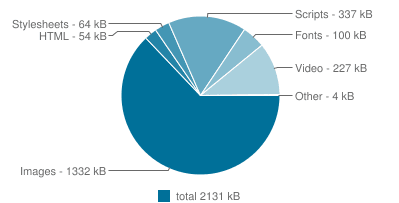The average web page is getting bigger. According to HTTP Archive, the average page size topped 2 MB this past April, and is now well over 2.1 MB. The following chart illustrates the breakdown of the byte size for various content types for the average page.

And the trend doesn’t seem to be slowing down. To get a perspective on the rate of growth, here’s a good overview how quickly page weight has increased over the past 2 decades.
But We Have Faster Internet Now, Right?
It’s clear that pages are getting bigger, but since we have faster connections now days, it shouldn’t really matter, right?
Not quite.
Although, we generally have faster connections, website performance isn’t necessarily getting better. Radware does regular studies of the top retailers on the internet. In their recent research during the Spring of 2015, they found that the average top 100 online retailer has an average Time to Interact (TTI) of 5.2 seconds. (TTI is a metric that measures when the primary page content has rendered and becomes interactive (i.e. clickable)).
In previous studies, they found that that anything over 3 seconds had a significantly negative impact on bounce and conversion rates. Yet, among the largest of the online retailers, only 14% rendered their featured content within 3 seconds, and 9% took over 10 seconds to do so. So even though we may have faster connections, even the top online retailers are having a hard time providing quick and optimal user experiences.
It’s interesting to note that the average page size of these online retailers was 1,354 kB, well below the current average on the internet as a whole. If they’re having difficulty, especially with page size well below average, imagine how the average 2.1 MB pages are performing.
Now all of this isn’t to say that things have necessarily gotten worse, but it is to say that faster connection speeds have not made the user experience significantly better on many sites. Because we know that people have faster connections, we’re tempted to worry less about optimizing our pages for loading quickly. But being lax in doing so can end up negating the opportunities for faster sites that higher speed connections provide.
How Important is Page Size, Anyway?
Of course, the size of the page isn’t the only metric thing that matters. But reducing the size of the page does tend to correlate with improved performance. Ultimately, though, the real quest is not to see how small of a page we can create, but how quickly we can give our visitors content they can see and interact with. And it’s because of this goal that it’s important to keep an eye on how page size is affecting performance. Because assuming that having faster connections will solve all our problems is not a safe assumption.